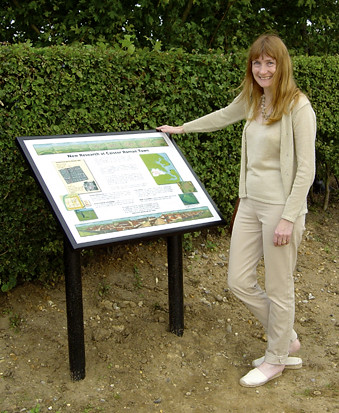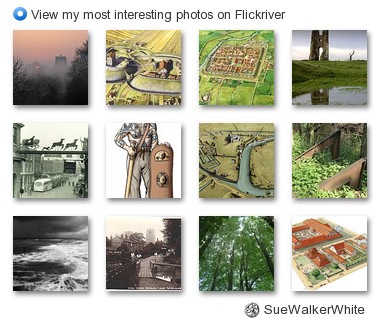
 It has been wonderful to have the chance of bringing back brasses to the church at Binham, as part of the lottery funded Binham Priory Access & Conservation Project. The recreation of the four figures will bring back some of the faces of people from the history of the Priory church. On the nave floor close to the altar there are five indents where figure brasses have been removed. One of the brasses of a civilian man of about 1530 still survives but is not in situ, he was removed for safe keeping after his wife was stolen in the 1980s. Luckily a brass rubbing of the pair survives so we have an exact copy of what she looked like. From the outline of two of the other indents it is possible to tell that they were brasses of parish priests or monks.
It has been wonderful to have the chance of bringing back brasses to the church at Binham, as part of the lottery funded Binham Priory Access & Conservation Project. The recreation of the four figures will bring back some of the faces of people from the history of the Priory church. On the nave floor close to the altar there are five indents where figure brasses have been removed. One of the brasses of a civilian man of about 1530 still survives but is not in situ, he was removed for safe keeping after his wife was stolen in the 1980s. Luckily a brass rubbing of the pair survives so we have an exact copy of what she looked like. From the outline of two of the other indents it is possible to tell that they were brasses of parish priests or monks.Bringing back the lost images to the church as tactile brasses once more is a very interesting project. Reuniting the images of the couple from the 1530s has been very satisfying, and searching for close matches for the two ecclesiastical brasses has been a challenge. I found a good parallel for the brass of the head and shoulders indent at Binham, in the brass of a priest at near by South Creake church. I am very grateful to the Vicar of South Creak for his help and permission to take a rubbing of the brass.




A full length indent at Binham is very similar to that of a monk's brass in St Alban's Cathedral, as Binham Priory was the daughter house of St Albans Abbey and several monks from there moved to Binham, it seemed fitting to use the image. To get the brasses cast it was necessary to make scale drawings of the images (that of the monk is shown above), these where then photographically etched into thick zinc sheet, this was then used to make a mold to cast the brasses in.
 The four brasses form the main feature of a children's area, as an activity for young visitors, families and school groups. They were mounted on a specially designed wooden support fixed to the back of one of the Victorian pine pews. It is made to pull out to form a brass rubbing platform, and fold flat as a display when not in use. A set of four children's' 'Discovery Sheets' accompany the brasses, each one looks at aspects of the contemporary life they each would have known. The discovery sheets and plain paper for taking rubbing are housed in a purpose built holder on the side of the pew.
The four brasses form the main feature of a children's area, as an activity for young visitors, families and school groups. They were mounted on a specially designed wooden support fixed to the back of one of the Victorian pine pews. It is made to pull out to form a brass rubbing platform, and fold flat as a display when not in use. A set of four children's' 'Discovery Sheets' accompany the brasses, each one looks at aspects of the contemporary life they each would have known. The discovery sheets and plain paper for taking rubbing are housed in a purpose built holder on the side of the pew.The small finds from the excavations of the Priory in the 1930s include several sizable pieces of monumental brass. They were part of one or more decorative canopies that would have surrounded a large figure brass. I would date the design of canopy to around 1400. A recent find by Cliff and Sue Hudson has provided a clue to the type of figure brass that may have stood under the canopy. They have found the knee section of a brass of a Knight in armour, which is nearly life sized. This high quality brass memorial would have been set in a stone tomb slab on the floor of the Priory church, in front or close to the altar. It probably depicts one of the patrons of the Priory who was buried in the church with the expectation that the monks would be forever praying for his soul. Who could this knight have been?

 (Left) An illustration of the type of figure brass and canopy that was once in the church at Binham.
(Left) An illustration of the type of figure brass and canopy that was once in the church at Binham.(Below) The excavated brass canopy fragments. You can see more images
here http://www.flickr.com/photos/suewhite/sets/72157603909944709/






2 comments:
Hi Sue,
I think you've identified the right workshop (J C P Kent's 'London B') in respect of your choice of comparison for the canopy and the armoured knee, I think you should be looking at a triple canopy in order to match the fragment at bottom centre. If you look at the V&A List, you'll find one that could be a close match on the illustration of J Sleford, a priest, at Balsham, Cambs. As neither armoured knees nor canopies change very much for a number of years, you could be looking at a range of c1390 to c1430, although the curve on the knee cop goes rather more triangular from c1400 to c1415 before reverting.
I'm less happy about the two ecclesiastics. The half effigy appears to me to be wearing mass vestments (straight-edged collar) rather than a cope like the one at South Creake, though it may well be of the same sort of date. I don't see any reason why the other one should be a monk as the slab is in the parochial part of the priory. As it's not the Purbeck marble you'd expect for a London made brass, I think the figure may well have come from the Norwich 1 workshop and have looked like Ralph Fuloflove at West Harling (see Greenwood & Norris, The Brasses of Norfolk Churches). However, as a representative of the sort of brass that might have been found in the monastic part of the church, I can't fault it.
Keep up the good work.
Jon
Dear Jon
Thank you so much for your detailed comments, I have only just found them! I will pass them on to the Heritage Group at Binham who will be very pleased at the extra information. I would like to give you proper credit for your identifications, how would you like to be credited? Many thanks for you help, I am so sorry I took so long to thank you. I will check the small boxes at the bottom of the posts more carefully from now on. Sue
Post a Comment